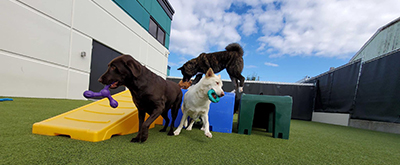Stress is a commonly used term to describe mental strain or anxiety. When humans experience stress, we tend to engage in activities to help alleviate that stress - and so do dogs! Did you know your dog can become stressed and anxious too? Knowing the behaviors and body language that dogs display when stressed (also known as "stress signals") can help you make changes to reduce the mental strain and anxiety on your beloved pet in the moment.
Dog Stress Signals
Dog stress signals can include pacing, shaking, lip licking, showing the whites of the eyes, excess shedding, and excessive panting. Other stress signals your dog may display include changes in their body posture, changes in ear positioning, and even changes in their bodily functions. Dogs have a tendency to avoid eye contact while in stressful situations or may display a prolonged yawn when feeling anxious - this yawn is more intense and exaggerated than a sleepy yawn.
More obvious dog stress signals include noticeable changes in their body posture. This can include a tail tucked between their legs and ears that are either pinned flat back against the head or are in a forward, alerted position. Some dogs will display behaviors such as freezing or submission. An example of submission includes rolling over and showing their belly. Submission is also commonly referred to as "shutting down" and is not being used in this article in a hierarchical sense.
Other noticeable dog stress signals may include changes in bodily functions. Stressed or anxious dogs may refuse food, drool excessively, have diarrhea, or change their urinary or bowel movement patterns (lose control of bowels or go a prolonged time without "going potty").
Being able to distinguish between relaxed behavior and stress signals is the most effective way to help alleviate your dog's anxiety because you will know when to act. Remember, what's normal for your dog might not be for another. The better you know your pet, the faster you will be able to pick up on behavioral or health changes.
Alleviating Dog Stress Signals
The first step in reducing your dog's stress signals and relieving their anxiety is to remove them from the stressor. Can you pinpoint what is causing the stress? If so, creating distance or blocking it from view is a good first step. Engaging in regular training sessions may also help alleviate dog stress signals. Establishing routines and regular sessions create a state of normalcy for your dog and make a great distraction from the stressors within their environment. Physical activities and exercise like playing fetch and walking will also reduce dog stress signals. Providing a safe, comfortable place for your dog to retreat to can also help to alleviate anxiety - this is one reason why crate training is so important.
Working and consulting with a professional dog trainer will also help you to identify what is causing your dog's anxiety and, in turn, alleviate stress signals. Biscuits Doggie Daycare and Pet Resort provides a qualified team of pet care professionals and dog trainers that work with your dog during enrichment daycare, overnight boarding, and training sessions. Biscuits Doggie Daycare and Pet Resort provides high quality care within a state of the art facility located on 6th avenue in Tacoma. Contact Biscuits Doggie Daycare and Pet Resort to meet with a certified professional dog trainer to better understand dog stress signals and how to reduce overall anxiety.
Twenty- and sixty-minute behavior consultations are available at Biscuits Doggie Daycare and Pet Resort that provide in-depth guidance and help to determine which training services are right for you and your dog.



